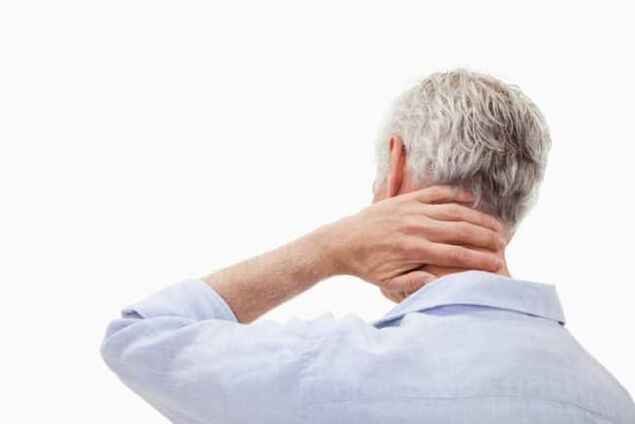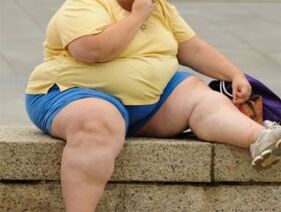In all pathological processes that affect the spine in their different parts, cervical osteochondrosis is considered one of the most common and painful.The disease leads to a lot of complications, mainly because it affects the spinal cord, and negatively affects the functioning of the brain.

What is cervical osteochondrosis?
In medical practice, the words of osteochondrosis of the cervix are an acquired progressive disease that affects the specific spine.This pathological process is characterized by degenerative-destrophic processes in the tissues of the intervertebral disc, which are shock absorbers for cervical vertebrae.The degenerative-dystrophic changes in the intervertebral disc are due to the fact that they have disappeared and deformed.As a result, the distance between the vertebra is reduced and the result is the following results:
- Contraction of spinal canal in some areas of the spine.
- Passing vertebral arteries - large blood vessels that provide blood supply to the brain.Due to which the brain supply in the cervical spinal cord deteriorates and blood circulation disappears.
- Intervertebral discs can be distorted and flattened.It squeezes the individual sections of the spinal cord and the veins, more often, the nerve roots are squeezed.
All these problems not only cause brain blood circulation, painful sensation in the neck, headache etc.The development of osteochondrosis of the cervical region is dangerous with problems of a neurological nature, deteriorating the central nervous system, damage to the brain tissues.According to diseases of international classification, many different codes were assigned osteochondrosis of the cervical region.The disease code for ICB 10 depends on the age of the disease: the disease was diagnosed:

- M02 - Dystrophy of intervertebral disc in adolescence.
- M42.12 is a diastrophic process in the neck in adults.
Many factors depend on the patient's age and the degree of development of the pathological process, for example, results, complications, symptoms, and of course, theory of treatment.
Reason
Knowing the cause of the development of osteochondrosis of the cervical field can lead to a decisive role in the process of diagnosis, as well as determination of the principles of dealing with the disease.However, before listing the reasons, it is worth saying that doctors separate two factors that lead to the development of this pathological process:
- Pathological - Destruction of intervertebral discs and other vertebrae with participation of nearby tissues, blood vessels and nerve beams in the pathological process under the influence of adverse external factors.The more difficult these factors and other deformities are, the faster the disease develops.
- Physiological - Depending on the development of pathology, mainly age -related changes.We are talking about the natural aging of cartilaginous tissues in spinal columns, salts, etc.
If we lie more specific causes of osteochondrosis of the cervix, they are as follows:
- Violation of metabolic processes in the body, as well as some stages of obesity.
- Hypodynamia is an event characterized by a range of mobility.It is not only about injuries or diseases, it can also include a sedentary lifestyle and seating.
- The pathology of the cardiovascular system, contributing to impaired blood circulation in the brain, changes in pressure and other things.
- Wrong postures, these are different forms of scoliosis, arthritis and even flat legs.
- Cervical spine injection.In this case, we are talking about sprains, attacks, injuries.Another spinal test in the development of cervical osteochondrosis may affect the development of osteochondrosis of the cervix.
- Depending on the type of human activity, extremely large physical exertion on the cervical region due to intensive sports or heavy physical difficulty.
- If you sit on incorrectly or uncomfortable furniture, a sedentary lifestyle is also dangerous with the cervical spine and constant stress of the entire spine.
- A hernia of the cervical spine, as well as various related diseases.
- Forced to hold a longer time of the head in an inconvenient or unnatural position.In this case, not only the muscle overstrains are, but the spine is also curved in the cervical region.
- Doctors consider constant stress and nervous overvoltage a very common cause.
- One of the reasons is also considered to be congenital anomalies in the spine structure.

What is the danger to health?
As mentioned earlier, in the cervical spine, not only the spinal cord and various nerve branches are located, but also the spinal arteries that supply the OCCPIL part of the brain, cerebellum and marrow brain.With the development of cervical osteochondrosis, nearby tissues are inflamed.In addition, the development of pathology threatens to squeeze nerve roots and transmit blood vessels, the results are as follows:
- Osteochondrosis is accompanied by the deformity of the spine, resulting in the cerebrospinal canal compressed in some areas.It can squeeze the spinal cord and neural branches, which promises severe neurological problems.In severe cases, a person feels pain, even there is a possibility of loss of control over the individual parts of the body (mainly in the hands or face).
- Squeezing the neck vessels, as already mentioned, is accompanied by violation of blood circulation in the oCCPital area of the brain.At the same time, the brain stops obtaining the required amount of oxygen and nutrients, oxygen starvation begins.With communication disorders, there is a real risk of ischemic stroke and various neurological pathology.
Syndrome
The main syndromes are:
- Ponder.
- Karrook artery.
- Korshaka.
- Cardiac.
It is important to know that each of these symptoms along with painful sensations of different nature is accompanied by lots of adverse clinical signs.A person can feel dizzy, a noise appears in his ears and much more.

Vertebral syndrome
It speaks of the direct relationship of osteochondrosis of the cervical region with bone and cartilaginous tissues.Symptoms in this type of pathology are also associated with the wounds of the mentioned tissues:
- The movement of the neck is partially or completely limited.
- Neck pain is accompanied by head movements.
- X -rare shows morphological changes in tissues (in the body of intervertebral and vertebral).
It is worth noting that the vertebral syndrome is always accompanied by these three clinical signals.If at least 1 of them is absent, the diagnosis will be completely different.
Rhetoric syndrome
This occurs when spinal roots are damaged.At the same time, nervous conductivity is disturbed, a person may feel pain or may lose sensitivity to the individual parts of the body or even suffer from paralysis.8 On which of radicular joints depends on, there is disturbance of conductivity, such symptoms are distinguished:
- 1 pair - numbness or pain behind the head;
- 3 pair - violation of chewing reflex, numbness of the tongue and unpleasant sensations behind the ears;
- 4 pair - Hansli pain, violation of swallowing reflex;
- 5 pair - violation of shoulder girdle with the problem of hand movement;
- 6 pair - The patient starts feeling pain and numbness in the forehead and shoulder blades;
- 7 pair - hands and fingers are numb (often index and middle);
- 8 pair - problems similar to previous items, but numbness is felt in ring finger and small finger.
Cardial syndrome
Despite the fact that the pathological process is still localized in the cervical spine, syndrome has all signs of heart diseases.The clinical picture is as follows:
- rapid pulse.
- Pain in the area of sternum.
- Shortness of breath, weakness, lethargy, decrease in performance.
Symptoms and symptoms of cervical osteochondrosis
To search for a doctor on time, it is necessary to clearly understand the signs of osteochondrosis of the cervix.In some cases, such knowledge allows you to take help in the early stages of the disease, when it is easy to treat.In general, the symptoms of osteochondrosis of the cervical spine are as follows:

- Pain for osteochondrosis is always present, only intensity and frequency varies.This is the pain which is the first clinical sign.Their intensity depends on the phase of the progression of the disease, in nature they fool or squeeze.Painful sensations are mainly present in the neck of the OCCPIL area, but the temporary region can also radiate in the shoulder and also in the hands.
- In most cases, there are manifestations of vestibular equipment lesions.We are constantly talking about reasons, nausea, impaired coordination of movements, uneven movements, loss in space.
- One of the most common clinical signs is the stiffness of the neck muscles and the stiffness of movements.It is difficult for a person to turn, reduce and throw your head, the movements responded with pain matches.
- Many patients take into account the feeling that the Gozbump "walks through the skull" or a characteristic tingling is felt.
- The area of hands has muscle weakness and numbness.
- There are often psychological manifestations, which are expressed in depression, drowsiness, rapid changes in mood, nature or irritability.
- Due to impaired blood circulation and damage to brain tissue, dizziness intensifies and noise appears in the ears, similar to rustling, beating, ringing.
- Most patients note visual loss, as well as eye pain in the eyeball, especially when the eyes try to turn the left, right, up or downwards.
It is possible to determine the degree of development of the disease process by sometimes symptoms.However, for a complete diagnosis of this, it is still not enough and requires many clinical measures.
Diagnosis methods
Diagnosis of osteochondrosis of cervical spine is necessary to determine the localization and phase of the progression of the disease.For complete diagnosis, such clinical methods are required:
- X -Ray - Primary method that allows you to determine the degree of deformation of the spinal column and localization.
- You can use calculation tomography for more accurate diagnosis of pathological changes in vertebrae and intervertebral discs.
- MRI (Magnetoresonance imaging) - makes it possible to examine the wheels and vertebrae, determining the presence of the scale of hernias, protrusions, and the rest of the lesions.
- Dopplerography - At the same time, one becomes an opportunity to find a place to squeeze the exam artery, evaluate the degree of communication disorders.
Treatment methods
Treatment of osteochondrosis of the neck always means an integrated approach.The principles of treatment depend on the mass of factors, such as the age of the patient, the stage of development of the disease, the glow of the clinical picture, etc.Nevertheless, you cannot do without a doctor in this condition and first you can consult a physician who will direct you to a vertebralologist.As for integrated approach: osteochondrosis of cervical osteochondrosis is treated using drug therapy, physiotherapy, massage, exercise therapy and other methods, which should be discussed in more detail.
Medicine treatment
The base for the treatment of cervical osteochondrosis is drug therapy, including the use of pills, medicines and drugs of such groups:
- Anesthetics - analgesic and antispasmodics.The pre -straight dull nervous center, which prevents painful sensations.The latter allows you to remove neck muscle spasms, installation of blood flow and suppress pain.
- NSAIDs -Non -storoidal anti -inflammatory drugs are required to reduce inflammatory process, most of them also eliminate pain.Often these drugs are used as gels, ointments, which are rubbed into the affected area.
- There is another way to remove muscle spasms in the cervical region.
- Chondroprotectors are mandatory in some stages of chops osteochondrosis, as they contribute to the restoration of bone tissue.
- B vitamins - normalize the metabolic processes of nerve tissues, improve the conductivity of nerve impulses and contribute to the functioning of the central nervous system.
Remember, treatment should only be done under the supervision of a doctor, which is responsible for the appointment of each drug, as well as determines the duration of its intake and dose.
Physical therapy
Treatment of neck osteochondrosis using some physiotherapy techniques will be many times more effective:

- Electrophores.
- Laser therapy.
- Ultrasound.
- Massage.
Massage therapy is necessarily performed by an experienced health worker, treatment is performed by a course of at least 10 sessions.Massage of the cervical region helps normalize blood circulation, restore elasticity, muscle tone, pain relief, etc.
manual therapy
The manual therapy is based on the principle of restoring motor functions and dynamics between the vertebrae.Initially, manipulations occur in a mild comfort massage, then the doctor attaches more and more strength, acts on the vertebrae of pressure and works on the bend of the neck.
The use of Kuznetsov applicants is one of the methods of therapy for spinal diseases, including osteochondrosis.The effect of adaptation on the cervical region normalizes metabolic processes, relieves pain, increases muscle tone, improves blood circulation, increases the conductivity of neural tissue, etc. To prevent osteochondrosis, attach to swimming and hang on an alternative bar every day.


























































































